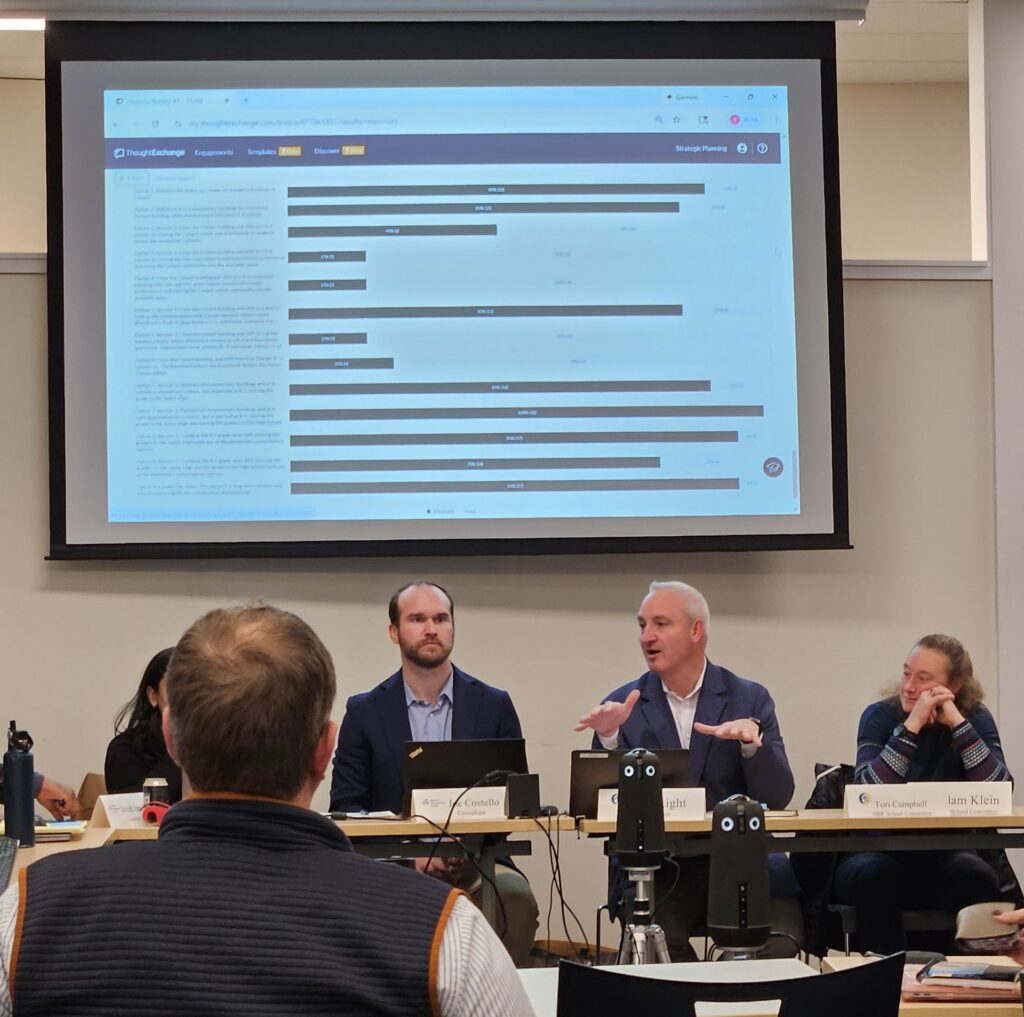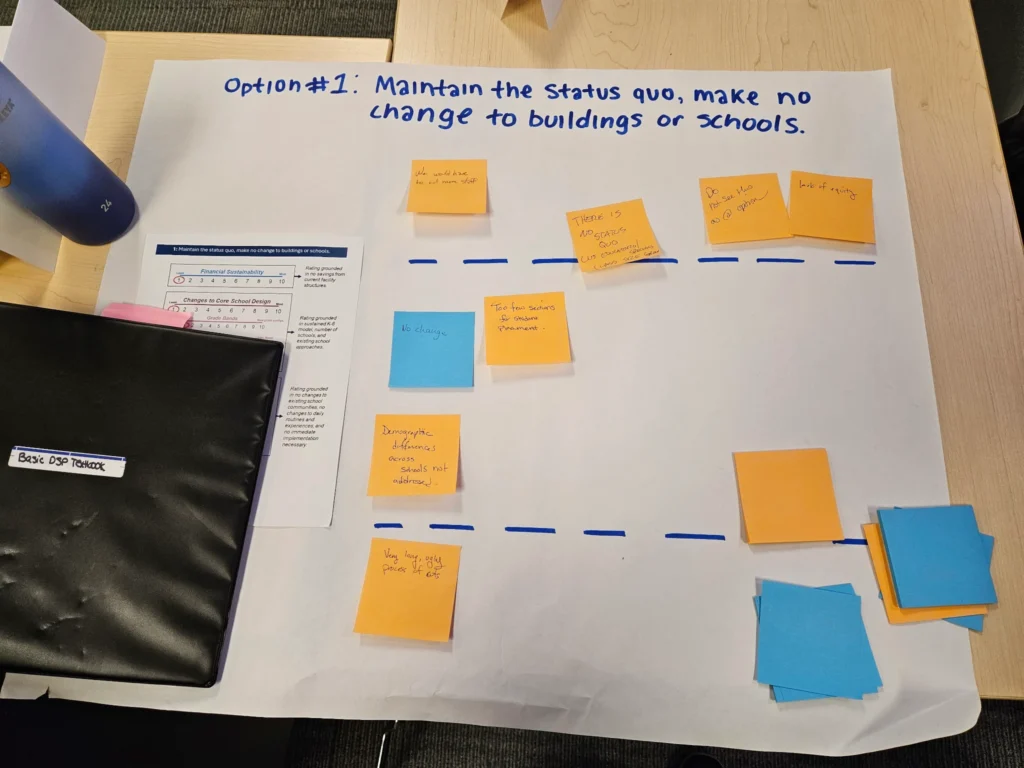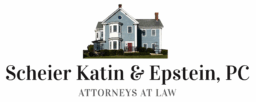The November 18 AB Forward Steering Committee meeting marked a turning point in Acton-Boxborough’s reorganization process, as members used new data and public feedback to begin narrowing long-term options for the district’s elementary schools.
In a critical step toward creating a financially sustainable model for the district, the committee voted to eliminate five potential reorganization options, most notably Option 1, which represented maintaining the status quo. This decision signals that closure of the Conant building is now inevitable, driven by a need to balance fiscal health with continued educational excellence. Note that the AB Forward process makes a distinction between “building” and “school.” In some scenarios, the “Conant School” community and approach could move to a different venue, without carrying forward the expense of maintaining the 1971 vintage facility.
What the committee reviewed
Ahead of the meeting, steering committee members received 101 pages of “Supplemental Information for District Reorganization Discussion” and 55 pages of public comments submitted through an online form. The supplemental packet included a district memo from Superintendent Peter Light, a research brief on school grade configurations, detailed enrollment and open-enrollment trends, classroom and capacity analyses, and preliminary operating cost and capital cost estimates for different models. The public comment file compiled dozens of submissions from families, staff, students, and residents, many of whom attached their names, addresses, and school affiliations.

Why reorganization is on the table
Enrollment in Acton-Boxborough’s elementary schools is at a 30-year low, even as the district maintains six K–6 schools across four elementary campuses, including aging facilities like Conant. The packet notes that the district currently has 147 full-size K–6 classrooms but uses only 117 for general education, with the rest repurposed for specialized programs, small groups, or simply because space is available.
Financial modeling presented to the committee showed that different reorganization scenarios could save up to roughly $2 million annually in operating costs, mostly through reductions in building-level administration, classroom staffing aligned to School Committee class-size guidelines, and utilities — money that could be redirected to District priorities or used to stabilize future budgets. At the same time, capital estimates indicate that renovating Conant to modern standards would likely cost in the range of $50–$100 million in today’s dollars, far above the district’s earlier $17 million placeholder from a 2016 study.
District Management Group’s previous recommendations to reprioritize cost savings are now outdated because they do not reflect the extraordinary financial pressures facing the district in this budget cycle, especially the surge in health insurance costs. This year, the district faces a budget shortfall of $2–3 million – about twice the size of gaps addressed in previous years, which typically ranged from $1 to $1.5 million. Unless substantial changes are made, maintaining the current structure and level of services would require severe cuts to staff and programs, making it clear that simply preserving the status quo is no longer possible under current conditions.
What research and community feedback said
Consultants Hanover Research summarized national studies and concluded there is no single “best” grade configuration, though models with fewer school transitions for students tend to show better academic, social-emotional, and behavioral outcomes. Research cited in the packet suggests that sixth graders often perform better and have fewer discipline issues when they remain in elementary settings (K–6 or K–8) rather than moving into standalone middle schools at grade 6, and that frequent transitions can disrupt relationships and increase behavior problems. Separately, District Management Group synthesized over 2,000 “touchpoints” with stakeholders — focus groups, community forums, and surveys — and reported that residents and staff share three core priorities: protecting student well-being and educational quality, achieving long-term financial sustainability, and sustaining strong school communities.
What options were on the table?
Survey materials asked stakeholders to rank 13 reorganization options, ranging from maintaining the status quo to closing buildings, merging schools, shifting to grade-banded elementary models, and even expanding the region. Several options focused on closing the Conant building and redistributing students among remaining schools, either as K–6 neighborhood schools or as larger grade-banded configurations using Blanchard, Boardwalk, and Parker Damon buildings. Other options considered moving grade 6, and in some cases grade 8, to the junior high and high school, and one long-term concept envisioned expanding the regional district beyond Acton and Boxborough.
How the November 18 meeting worked
Over roughly three hours, steering committee members reviewed the data, discussed tradeoffs, and used a structured process, two rounds of voting with time for written “sticky note” comments between rounds, to narrow the field. Members weighed cost savings, capacity constraints, capital needs, alignment with research on school transitions, and the intensity of community concern or support evident in the public comments. The goal was not to pick a final plan but to focus further analysis on a smaller set of options to refine before presenting a recommendation to the School Committee in December.

Which options were eliminated?
By the end of the evening, five options were off the table:
- Option 1: Maintain the status quo.
- Option 7, Version 1: Maintain all 4 elementary buildings and all 6 individual elementary schools, but organized as K-5, moving 6th grade to the Junior High.
- Option 7, Version 2: Maintain all 4 elementary buildings and all 6 individual elementary schools, but organized as K-5, moving 6th grade to the junior high and moving 8th graders to the high school.
- Option 8, Version 1: Combine the K-5 grade-level shift (moving 6th graders to the junior high) with any of the elementary consolidation options.
- Option 9: Expand the region (this option is a long-term solution and would require significant coordination and planning).
Removing the “status quo” option signaled that the committee now views some form of reorganization as necessary, given projected enrollment, facility needs, and the district’s fiscal outlook.

What residents are saying
Public comments reflect a community that is both deeply attached to its schools and sharply aware of financial constraints. Many families urge the district to protect K–6 elementary communities, citing benefits such as older students mentoring younger ones, multi-age school events, and the stability of spending seven years in one building. Others, including some parents, educators, and elected officials, argue that the district must “cut deep” once to reach a sustainable model that avoids repeated crises, even if that means closing or merging beloved schools and rethinking open enrollment.
School identity, choice, and equity
A recurring theme in the comments is the fear that closure or consolidation decisions could stigmatize particular schools or erase unique educational models. Merriam families and staff highlight its looping and project-based learning as an asset that cannot be captured by enrollment-preference statistics alone, while Conant supporters emphasize its national Blue-Ribbon recognition and strong test scores despite an outdated building. Boxborough residents stress that Blanchard’s role as a true hometown K-6 school was a key assumption when the elementary grades regionalized, and many strongly oppose any option that would turn Blanchard into a single-grade or PreK-only building.

Transitions, mental health, and Covid memories
Parents and educators repeatedly connect reorganization decisions to student mental health, particularly for children whose early schooling was disrupted by the Covid-19 pandemic. Several commenters warn that frequent building moves or shifting grade bands could destabilize students who are still recovering academically and emotionally from that period. Others note that research in the district’s own packet points to the downsides of multiple transitions in the middle grades, and raise concerns about proposals that would move eighth graders into the high school.
After the meeting, Alissa Nicol, vice chair of the Acton Select Board, said, “Acknowledging that this process is distressing, that both families and school staff are feeling anxiety about the uncertainty of what lies ahead, my hope is that the community can pivot. Can we all make an effort to shift our focus from anger and grief over the loss of something we hold dear to a focus on the possibility of a more stable district that serves us well, perhaps even better? Special school communities are built by the people in them, and we can build new communities that are special and serve the educational needs of current students and the next generation of grade school students.”
What people want to know next
Across stakeholder groups, there are clear calls for more detailed, transparent analysis of each remaining option. Residents ask for class-size projections by grade and building, specifics on how many positions might be reduced or repurposed, and clearer explanations of how cost savings would be used to support teaching, special education, mental health, and enrichment. Others want to see how different options would affect open enrollment, neighborhood school access, bus routes, and the feasibility of keeping siblings in the same school.
Many parents are strong supporters of the school that their children attend, and are leery of losing the thing that makes that school unique. For example, following the meeting, a parent who has been following the process closely, said, “The fact that closure and merger options (3.1, 3.2, and 4) remain on the table at this point is a distraction and disservice to our children and our community. It delays conversations about how we move to a financially sound model that preserves the best of what is available district-wide. That being said, if the district wants to have that conversation, it must be a balanced one. The qualitative data analysis provided publicly is skewed in favor of one school. Without a balanced view, the committee does not have a robust understanding of consequences of choices that remain available. If the district chooses to close or merge [school name], we lose a school with a fundamentally unique pedagogical structure because its benefits cannot be summarized in a sound bite.”
What this means for Acton residents
For Acton readers, the November 18 meeting confirms that change is coming to the elementary system, but also that there is still time to influence how that change takes shape. The steering committee has ruled out doing nothing and has culled some of the most controversial grade-shift and regional expansion ideas, while keeping on the table several consolidation and configuration models that differ in how they balance cost savings, stability, and school identity. The School Committee is expected to consider a smaller set of fully developed options in December, making the next few weeks a critical period for informed, constructive public engagement. For information about future public meetings and how to submit a comment, see the AB Forward website.
After the meeting, Tori Campbell, chair of the School Committee, said, “We’ve heard people say this decision is happening too fast, and others say it isn’t happening fast enough. We deliberately chose an open, community-centered process because we believe a decision of this magnitude will work out best when everyone can see the work and help shape it. Our community has provided incredibly thoughtful feedback thus far. This not only helps us understand what we are asking of each other, but gives me deep hope that whatever structure we eventually select, our community will continue to fill it with the connection, creativity, and care that define our schools at their best.”
Campbell added, “We invite our community to continue to engage in this dialogue by following our progress on the AB Forward website, sharing thoughts and questions through the AB Forward Steering Committee public comment form, emailing the School Committee’s email shell (abrsc@abschools.org), listening in as both Steering Committee and School Committee do their work during business meetings, and participating in public comment at meetings. There will be an extended opportunity to provide feedback during the January 8 School Committee meeting. The School Committee will vote on the reorganization plan at our Jan 22 meeting, allowing the administration just enough time to integrate this decision into the budget proposal for next year.”
How the Acton Exchange Team wrote this story
The Acton Exchange Team recognized that turning the AB Forward Steering Committee Meeting materials for November 18, 2025 into an article that provides accurate and trustworthy information, tells a compelling story, and is relevant to the interests of Acton residents, required a different approach. In many cases, there is a recording and transcript available for meetings to allow authors to verify their notes. However, ActonTV did not record this meeting, which meant that the writer needed to rely heavily on existing materials and discussions with AB Forward committee members.
So, the status quo was out. Instead, we adopted the use of AI, slowly, and only after prior discussion with editors. We crafted a long, detailed prompt. We uploaded 101 pages of “Supplemental Information for District Reorganization Discussion” as well as 55 pages of “Strategic Planning & Reorganization Steering Committee Public Comments” to four AI engines: ChatGPT, Gemini, Perplexity, and NotebookLM. Then, we reviewed the four draft articles, which ranged from 712 words to 1,506 words long, and shared detailed feedback at our All-Hands meeting on Wednesday, November 19, 2025. After verifying outputs against primary sources, and layering in human expertise, we selected the 1,232 words generated by Perplexity as our rough draft. Then, we added what no AI engine can do: comments from people who were “in the room where it happened”, keeping with the Acton Exchange mission to reflect diverse voices and encourage civic and community engagement.
Note: The last two paragraphs were written without the assistance of AI.













